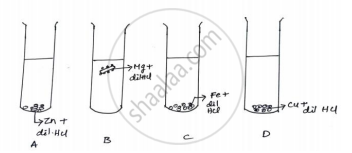Advertisements
Advertisements
Question
Answer the following question:
What is corrosion? Do gold ornaments corrode? Justify.
Solution
- The slow process of decay or distinction ions of a metal due to the effect of air, moisture, acids, alkalies, or other chemicals on it is called corrosion.
- Ordinarily, gold ornaments do not get corroded.
- Gold is one of the least reactive metals. It does not react with air, moisture, sweat, or ordinary pollutants in air or water. Hence, it does not get corroded.
APPEARS IN
RELATED QUESTIONS
Explain the terms Corrosion
The chemical reaction involved in the corrosion of iron metal is that of:
(a) oxidation as well as displacement
(b) reduction as well as combination
(c) oxidation as well as combination
(d) reduction as well as displacement
Name the metal which is used for galvanising iron.
Fill in the following blank with suitable word:
The process of depositing a thin layer of zinc on iron articles is called .............
Fill in the following blanks with suitable words:
............ and .............. are necessary for the rusting of iron.
Explain why, through aluminium is more reactive than iron, yet there is less corrosion of aluminium when both are exposed to air.
What are the special properties of stainless steel?
Name an alloy of copper. State its chemical composition and any one use.
Explain why, when a copper object remains in damp air for a considerable time, a green coating is formed on its surface. What is this process known as?
Explain why, the galvanised iron article is protected against rusting even if the zinc layer is broken.
A common metal which is highly resistant to corrosion is:
(a) iron
(b) copper
(c) aluminium
(d) magnesium
Mention two uses of the following metals and non-metals
Iron
Name the metal which is a constituent of plant pigment?
What is corrosion? What are necessary conditions for corrosion?
Corrosion can be an advantage in some case.Explain ?
Compare roasting and calcination.
Complete the process of iron rusting by filling the blanks. Suggest a way to prohibit the process.
The iron rust is formed due to........................... reaction. Different
regions on iron surface become anode and cathode.
Reaction on anode region :
`F_e(s) → Fe^(2+) (aq) +2e^-`
Reaction on anode region :
`O_2(g) + 4H^+(aq) +............................ → 2H_2 O (l) `
When Fe2+ ions migrate from anode region they react with ................... to form Fe3+ ions.
A reddish coloured hydrated oxide is formed from ............... ions. It is called rust.
`2Fe_(3+) (aq) + 4H_2O(l) → ................. + 6H_+(aq) `
A way to prevent rusting ..................................................................
Find the odd man out:
What is done to prevent corrosion of metals?
What is "rusting"? Describe with a labelled diagram an activity to investigate the conditions under which iron rusts.
Observe the following picture and answer the following questions:

- What is rust?
- Write the chemical formula of rust.
- Write the reaction of oxidation of iron at the anode.
- Write the reaction of oxidation of iron at the cathode.
- What is corrosion?
Which of the following method is used to prevent the accumulation of greenish layer on brass due to corrosion?
Corrosion of silver causes a black layer of _______.
To prevent corrosion of iron and steel _______ method is used.
Bronze : _______ : : Stainless steel : Fe + Cr + C
Draw a neat labelled diagram.
Electroplating
Draw a neat labelled diagram.
Anodizing
Complete flow chart given below.

Observe the following diagram and write answers.

- Name the method.
- Explain the method.
- Give two examples of this method.
Observe the following figure and write the answer of the question.

- Which process is shown in the figure?
- Explain the chemical reaction shown in the figure.
- Write the reactions on anode and cathode.
The process of coating the surface of the metal with a thin layer of zinc is called ______
What is rust?
Amalgam is an alloy of ____________.
The diagram shows the reaction between metal and dil. acid.

What is the reason for different behaviour of Mg in test tube B?
Marble’s popularity began in ancient Rome and Greece, where white and off-white marble were used to construct a variety of structures, from hand-held sculptures to massive pillars and buildings.

The substance not likely to contain CaCO3 is:
Galvanisation is a process used to prevent the rusting of which the following?
| A process of forming a thick oxide of aluminium when aluminium is exposed to air. This coat makes it resistant to corrosion. Resistance can be improved by making a layer of oxide thinker. In this technique, the aluminium article is the anode, and the electrolyte is sulphuric acid. The anode reaction results in the formation of a black-coloured film of aluminium oxide on the anode. By putting appropriate dyes in the electrolytic solution, both coloured surface with the decorative finish is achieved. Kitchen articles like anodised such as pressure cookers, pans and frames of sliding windows are applications of this technique. |
- Name the anode and electrolyte used in this technique.
- How can we make aluminium articles made resistant to corrosion?
- Name the technique used to coat the aluminium articles.
